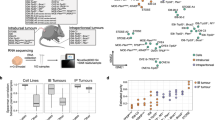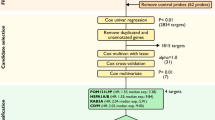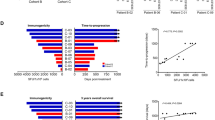Abstract
Ovarian adenocarcinomas develop as the result of multiple genetic and epigenetic changes in the precursor ovarian surface epithelial (OSE) cells which result in a malignant phenotype. We investigated changes in gene expression in ovarian adenocarcinoma using a cDNA array containing 588 known human genes. We found that intercellular adhesion molecule-1 (ICAM-1) was expressed at lower levels in the ovarian tumour cell lines OAW42, PEO1 and JAM than in the immortalised human ovarian surface epithelial cell line HOSE 17.1. Further investigation revealed ICAM-1 was expressed in the surface epithelium of normal ovaries and both mRNA and protein expression levels were reduced in the majority of ovarian adenocarcinoma cell lines and primary tumours. ICAM-1 expression was increased in 8/8 cell lines treated with the de novo methyltransferase inhibitor 5-aza-2′-deoxycytidine, indicating that methylation of CpG islands may play a role in the down-regulation of its expression in primary tumours. There was a significant association between patients whose tumours expressed ICAM-1 and survival (P= 0.03), suggesting that expression levels of ICAM-1 may have clinical relevance. © 2001 Cancer Research Campaign http://www.bjcancer.com
Similar content being viewed by others
Article PDF
Change history
16 November 2011
This paper was modified 12 months after initial publication to switch to Creative Commons licence terms, as noted at publication
References
Amfo K, Neyns B, Teugels E, Lissens W, Bourgain C, De Sutter P, VanDamme B, Vamos E and De Greve J (1995) Frequent deletion of chromosome 19 and a rare rearrangement of 19p13.3 involving the insulin receptor gene in human ovarian cancer. Oncogene 11: 351–358
Arnold JM, Mok SC, Purdie D and Chenevix-Trench G (2001) Decreased expression of the Id3 gene at 1p36.1 in ovarian adenocarcinomas. Br J Cancer 84: 1–8
Buick RN, Pullano R and Trent JM (1985) Comparative properties of five human ovarian adenocarcinoma cell lines. Cancer Res 45: 3668–3676
Burno DK, Kyprianou N, Sartor W, Fabian DF, Turner J, Vu T, Patel A, Trimbach C and Lefor AT (1995) Transfection of a murine fibrosarcoma with intercellular adhesion molecule-1 enhances the response to adoptive immunoptherapy. Surgery 118: 237–244
Burno DK, Fabian DF and Lefor AT (1996) ICAM-1 increases in vitro adhesion and cytotoxicity in a murine fibrosarcoma. J Surg Res 60: 398–402
Chenevix-Trench G, Leary J, Kerr J, Michel J, Kefford R, Hurst T, Parsons P, Friedlander M and Khoo SK (1992) Frequent loss of heterozygosity on chromosome 18 in ovarian adenocarcinoma which does not always include the DCC locus. Oncogene 7: 1059–1065
Cheng P, Schmutte C, Cofer KF, Felix JC, Yu MC and Dubeau L (1997) Alterations in DNA methylation are early, but not initial, events in ovarian tumorigenesis. Br J Cancer 75: 396–402
D’Angelica M, Tung C, Allen P, Halterman M, Delman K, Delohery T, Klimstra D, Brownlee M, Federoff H and Fong Y (1999) Herpes simplex virus (HSV)-mediated ICAM-1 gene transfer abrogates tumorigenicity and induced anti-tumour immunity. Mol Med 5: 606–616
Diamond MS, Staunton DE, Marlin SD and Springer TA (1991) Binding of the integrin Mac-1 (CD11b/CD18) to the third immunoglobulin-like domain of ICAM-1 (CD54) and its regulation by glycosylation. Cell 65: 961–971
Fearon ER (2000) BRCA1 and E-cadherin promoter hypermethylation and gene inactivation in cancer-association or mechanism?. J Natl Cancer Inst 92: 515–517
Fogh J and Trempe G (1975) New human cell lines. In: Fogh J (ed) Human tumour cells in vitro, 155–159, Plenum: New York
Hamilton TC, Young RC, McKoy WM, Grotzinger KR, Green JA, Chu EW, Whang-Peng J, Rogan AM, Green WR and Ozols RF (1983) Characterization of a human ovarian carcinoma cell line (NIH:OVCAR-3) with androgen and estrogen receptors. Cancer Res 43: 5379–5389
Johnson JP (1991) Cell adhesion molecules of the immunoglobulin supergene family and their role in malignant transformation and progression to metastatic disease. Cancer Metastasis Rev 10: 11–22
Johnson JP, Stade BG, Holzmann B, Schwable W and Riethmuller G (1989) De novo expression of intercellular-adhesion molecule 1 in melanoma correlates with increased risk of metastasis. Proc Natl Acad Sci USA 86: 641–644
Kaiserlian D, Rigal D, Abello J and Revillard JP (1991) Expression, function and regulation of the intercellular adhesion molecule-1 (ICAM-1) on human intestinal epithelial cell lines. Eur J Immunol 21: 2415–2421
Kikuchi T, Joki T, Akasaki Y, Abe T and Ohno T (1999) Induction of antitumour immunity using intercellular adhesion molecule-1 (ICAM-1) transfection in mouse glioma cells. Cancer Lett 142: 201–206
Koyama S, Ebihara T and Fukao K (1992) Expression of intercellular adhesion molecule 1 (ICAM-1) during the development of invasion and/or metastasis of gastric carcinoma. J Cancer Res Clin Oncol 118: 609–614
Kruk PA, Maines-Bandiera SL and Auersperg NA (1990) Simplified method to culture ovarian surface epithelium. Lab Invest 63: 132–136
Langdon SP, Lawrie SS, Hay FG, Hawkes MM, McDonald A, Hayward IP, Schol DJ, Hilgers J, Leonard RCF and Smyth JF (1988) Characterization and properties of nine human ovarian adenocarcinoma cell lines. Cancer Res 48: 6166–6172
Lin H, Huber R, Schlessinger D and Morin PJ (1999) Frequent silencing of the GPC3 gene in ovarian cancer cell lines. Cancer Res 59: 807–810
McCluskey LL, Chen C, Delgadillo E, Felix JC, Muderspach LI and Dubeau L (1999) Differences in p16 gene methylation and expression in benign and malignant ovarian tumours. Gynecol Oncol 72: 87–92
Natali P, Nicotra MR, Cavaliere R, Bigotti A, Romano G, Temponi M and Ferrone S (1990) Differential expression of intercellular adhesion molecule 1 in primary and metastatic melanoma lesions. Cancer Res 50: 1271–1278
Ogawa Y, Hirakawa K, Nakata B, Fujihara T, Sawada T, Kato Y, Yoshikawa K and Sowa M (1998) Expression of intercellular adhesion molecule-1 in invasive breast cancer reflects low growth potential, negative lymph node involvement, and good prognosis. Clin Cancer Res 4: 31–36
Parkin DM, Pisani P and Ferlay J (1999) Estimates of the worldwide incidence of 25 major cancers in 1990. Int J Cancer 80: 827–841
Ropers HH and Mohrenweiser H (1993) Report of the committee on the genetic constitution of chromosome 19. Genet Prior Rep 1: 524–547
Sambrook J, Fritch EF and Maniatis T (1989). Molecular cloning: A laboratory manual, second edition, Cold Spring Harbour Laboratory Press: New York
Schwaeble W, Kerlin M, Meyer Zum Buschenfelde K and Dippold W (1993) De novo expression of intercellular adhesion molecule-1 (ICAM-1, CD54) in pancreas cancer. Int J Cancer 53: 328–333
Shibata M, Ando K, Amano S and Kurosu Y (1996) Local expression and circulating form of ICAM-1 in colorectal cancer. Ann. Cancer Res. Ther 5: 29–33
Springer TA Adhesion receptors of the immune system. (1990). Nature 346: 425–434
Springer TA, Dustin ML, Kishimoto TK and Marlin SD (1987) The lymphocyte-function-associated LFA-1, CD2 and LFA-3 molecules: Cell-adhesion receptors of the immune system. Ann Rev Immunol 5: 223–252
Strathdee G, MacKean MJ, Illand M and Brown R (1999) A role for methylation of the hMLH1 promoter in loss of hMLH1 expression and drug resistance in ovarian cancer. Oncogene 18: 2335–2341
Tomita Y, Nishiyama T, Watanabe H, Fujiwara M and Sato S (1990) Expression of the intercellular adhesion molecule-1 (ICAM-1) on renal-cell cancer: possible significance in host immune responses. Int J Cancer 46: 1001–1006
Tsao S-W, Mok SC, Fey EG, Fletcher JA, Wan TSK, Chew E-C, Muto MG, Knapp RC and Berkowitz RS (1995) Characterization of human ovarian surface epithelial cells immortalized by human papilloma viral oncogenes (HPV-E6E7 ORFs). Exp Cell Res 218: 499–507
Uzendoski K, Kantor JA, Abrams SI, Schlom J and Hodge JW (1997) Construction and characterization of a recombinant vaccinia virus expressing murine intercellular adhesion molecule-1: induction and potentiation of antitumour responses. Hum Gene Ther 8: 851–860
Vogetseder W, Feichtinger H, Schulz TF, Schwaeble W, Tabaczewski P, Mitterer M, Bock G, Marth C, Dapunt O, Mikuz G and Dierich MP (1989) Expression of 7F7-antigen, a human adhesion molecule identical to intercellular adhesion molecule-1 (ICAM-1) in human carcinomas and their stromal fibroblasts. Int J Cancer 43: 768–773
Wang Z-J, Churchman M, Campbell IG, Xu W-H, Yan Z-Y, McCluggage WG, Foulkes WD and Tomlinson IPM (1999) Allele loss and mutation screen at the Peuta-Jeghers (LKB1) locus (19p13.3) in sporadic ovarian tumours. Br J Cancer 80: 70–72
Ward BG, Wallace K, Shepherd JH and Balkwill FR (1987) Intraperitoneal xenografts of human epithelial ovarian cancer in nude mice. Cancer Res 47: 2662–2667
Wei K, Wilson JG, Jurgensen CH, Iannone MA, Wolberg G and Huber BE (1996) Xenogeneic ICAM-1 gene transfer suppresses tumourigenicity and generates protective antitumour immunity. Gene Ther 3: 531–541
Wilson AP (1984) Characterization of a cell line derived from the ascites of a patient with papillary serous cystadenocarcinoma of the ovary. J Natl Cancer Inst 72: 513–520
Wolf CR, Hayward IP, Lawrie SS, Buckton K, McIntyre MA, Adams DJ, Lewis AD, Scott ARR and Smyth JF (1987) Cellular heterogeneity and drug resistance in two ovarian adenocarcinoma cell lines derived from a single patient. Int J Cancer 39: 695–702
Woods LK, Morgan RT, Quinn LA, Moore GE, Semple TU and Stedman KE (1979) Comparison of four new cell lines from patients with adenocarcinoma of the ovary. Cancer Res 39: 4449–4459
Wong AST, Maines-Bandiear SL, Rosen B, Wheelock MJ, Johnson KR, Leung PCK, Roskelley CD and Auersperg N (1999) Constitutive and conditional cadherin expression in cultured human ovarian surface epithelium: influence of family history on ovarian cancer. Int J Cancer 81: 180–188
Author information
Authors and Affiliations
Rights and permissions
From twelve months after its original publication, this work is licensed under the Creative Commons Attribution-NonCommercial-Share Alike 3.0 Unported License. To view a copy of this license, visit http://creativecommons.org/licenses/by-nc-sa/3.0/
About this article
Cite this article
Arnold, J., Cummings, M., Purdie, D. et al. Reduced expression of intercellular adhesion molecule-1 in ovarian adenocarcinomas. Br J Cancer 85, 1351–1358 (2001). https://doi.org/10.1054/bjoc.2001.2075
Received:
Revised:
Accepted:
Published:
Issue date:
DOI: https://doi.org/10.1054/bjoc.2001.2075
Keywords
This article is cited by
-
Lipophagy-ICAM-1 pathway associated with fatty acid and oxygen deficiencies is involved in poor prognoses of ovarian clear cell carcinoma
British Journal of Cancer (2022)
-
Prognostic utility of the ovarian cancer secretome: a systematic investigation
Archives of Gynecology and Obstetrics (2022)
-
CAMK2N1/RUNX3 methylation is an independent prognostic biomarker for progression-free and overall survival of platinum-sensitive epithelial ovarian cancer patients
Clinical Epigenetics (2021)
-
Pathological and prognostic significance of matrix metalloproteinase-2 expression in ovarian cancer: a meta-analysis
Clinical and Experimental Medicine (2016)
-
Differential expression of alternatively spliced transcripts related to energy metabolism in colorectal cancer
BMC Genomics (2016)



